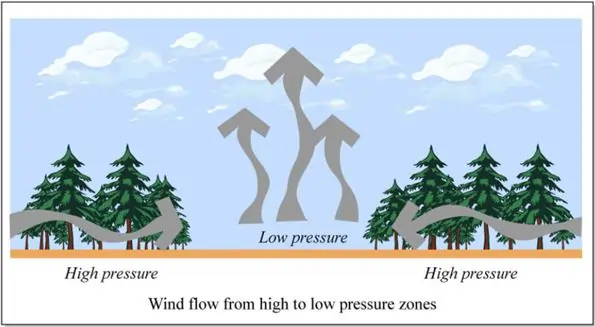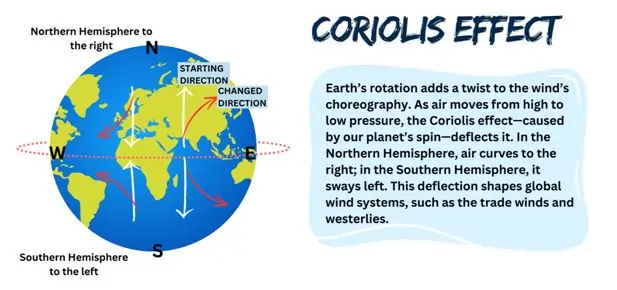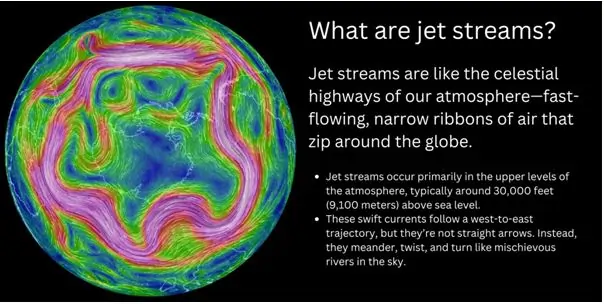What Is Wind?
Wind may be defined as the natural and continuous movement or displacement of air or other gaseous substances in the earthly atmosphere with reference to a planet’s surface. It is similar to lungs of the Earth supplying and exchanging heat, moisture and energy with one place to another through the currents.
Causes of Wind:
- Pressure Differences: It is important to show that the main reason for wind is the disparities of pressure in the atmosphere. Here’s the essence: It is important to understand that when the Sun heats the Earth, things are not as simple as it may seem. In the regions of the equator there is more sun exposure and thus the air is warm and has low density. Rise of hot air cause low pressure in atmosphere. At the same time, colder air near poles as dense and sinks and create the areas of high pressure. This means air will shift from one region of high pressure to another region of low pressure hence causing wind.

- Temperature and Solar Radiation: Heating of the solar radiation affects the surface of the Earth. Areas of the equator get more direct sunlight which forces warm air to rise thus developing low pressure areas. Air is cooler near the poles and as a result it becomes dense and forms a high pressure at the poles. This pressure difference caused by the temperature makes wind to start and it’s like a dance that takes place across the latitudes and longitudes in the sky.
- Coriolis Effect: The wind however is not just pulled from left to right or passed from one point to the other in a linear direction but is rather rotated through the Earth’s rotation. This force is caused due to Rotational force. During the shift of air it takes place. Moving through the Northern Hemisphere, air bends right while traveling south of the equator, it gyrates to the left. This deflection defines global wind patterns.
- Friction: Large structures such as trees, buildings and even mountains have the tendency of reducing the velocity of the wind particularly at the base of the structural formation. That is why at higher altitudes, wind speeds are higher which increase continuously because the air there literally glides elegantly without any interruption.
- Topography: The nature of the land also contributes in the process in one way or the other. Anticipated landscape characteristics, such as extensive plains, deep valleys, and mountain chains affect either facilitate or hinder the winds and their velocity. For example, windward area of mountains experience moisture while leeward regions or rain shadows experience dryness because of falling air.
Factors Affecting Wind Movement:
- Pressure Gradient Force: Pressure variation result to pressure gradient force due to differences in pressure.

- Coriolis Force: Direction of winds is directed by earth’s rotation. Coriolis effect tells that in the Northern Hemisphere the winds move in a counter clockwise direction. And in the Southern Half wind moves clockwise.
- Frictional Force: Difficult terrain does not allow wind movement in its direction due to the drag force.
- Centripetal Force: This force drags, inwards, keeping cyclonic wind circulations, around highs and lows, in circular manner.
- Atmospheric Pressure: This means that pressure variations produces wind. For warm air to rise it means that it creates low pressure while cold air, it means that it makes formation of highs pressure.
Types of Winds
Primary Winds (Planetary Winds):
- Definition: type of winds which occur throughout the year blowing in certain directions across the face of the globe. In a way, you can say they are the wise old members of the wind family.
- Also Known As: Depending on their direction they could be called as the trade winds or anti-trade winds, the planetary winds.
- Examples:
- Trade Winds: mostly used by traders during the sea voyages gave it the name trade wind. These are Steady winds. As its characteristic it moves from the subtropics towards equator, former has a high pressure while latter has a low pressure belt. In the Northern Hemisphere it is called north-eastern trade whereas in the Southern Hemisphere, it is called south-eastern trade.
- Westerlies: These winds move from the subtropical high pressure areas near the equator to the sub polar low pressure areas. Originally, sailors used to name them as ‘Roaring Forties’ and the ‘Furious Fifties’ because of the gusts that they produce.
Secondary Winds (Periodic Winds):
- Definition: The secondary winds change direction according to certain circumstances such as seasonal or periodic wind circulation conditioned by the Earth tilt, variations of temperature, and local conditions.
- Examples:
- Monsoon Winds: They cause severe fluctuations of seasons particularly in the South Asian region. During the summer, warm and humid air from the Indian Ocean moves to the Indian subcontinent thus enhancing farming by providing rainfall. Reversal of monsoon does take place in the winters where it brings a hot air to the sea.
- Sea Breeze and Land Breeze: These are local winds which blow near the coasts. During the day wind moves from the cooler sea to warm land this wind is known as Sea breeze. And, at night, when the day heat subsides, you get a land breeze blowing from the land to the sea.
- Mountain and Valley Breeze: In the mountain areas, heating in the day makes the air to move upwards through the valley (valley breeze). At night, situation is reverse; cooler air comes down; hence, called mountain breeze.
Tertiary Winds (Local Winds):
- Definition: Tertiary winds are not dominating and cover only a limited territory. You might say they’re the winds of the neighbourhood: special, idiosyncratic and frequently associated with geographic location.
- Examples:
- Loo: A dry and hot desert wind blowing in the northern parts of India especially during the hot summer season. It’s such as nature’s hair dryer at the highest power, equivalent to making a loud noise of a jet aircraft taking off.
- Foehn:Foehn, common in the Alps, isan warm dry winds that blow alpine regions from the side of the mountain where snow melts and temperature variation is very quick.
- Bora: A cold and gusty wind blowing down the mountains into the Adriatic Sea particularly in the Balkans region.
Major Local Winds in the world
Africa:
- Berg Wind: A seasonal katabatic wind that blows down the Great Escarpment from the high central plateau to the coast in South Africa.
- Cape Doctor: A sometimes continuing and characteristically dry wind that blows along the South African coast from spring to late summer – that is September to March on the South African calendar.
- Haboob: The highly mobile and large volume of sandstrom, which blows at a wind speed and brings cold temperatures over the area it sweeps across.

Asia:
- Karaburan: It is a type of winds blowing generally in spring and winter and it is one of the katabatic winds blowing in central Asia.
- Khazri: A cold, coastal gale force wind over the northern part of Caspian Sea.
- Karakaze: A cold mountain wind from the Gumpa prefectured area, in Japan.
- Oroshi: A steep katabatic wind, the likes of which swept through the Kanto Plain.
- Barguzin Wind: Wind blowing calmly and powerfully on the water of Lake Baikal in Russia.
- Sarma: A gust of cold wind at the southern coast of the world’s deepest and oldest lake – the lake Baikal.
- Elephanta: A mean, deep or fresh gustle of southerly or south-easterly wind on the Malabar coast of India.
- Kali Andhi (Andhi): Pre monsoon violent dust squalls that thrive in the north western region of the Indo-Gangetic Plain.
- Mango Showers: Along with this, there are thunderstorms which result to rainfall in Karnataka, Kerala and parts of Tamil Nadu during the month of March and April.
Other Continents:
- Europe: Some local effects are namely Mistral (France), Bora (Adriatic Sea), and Foehn (Alps).
- North America: There are two most famous streams namely the Chinook (Rocky Mountains) and the Santa Ana (Southern California).
- South America: The Pampero is a wind that affects Argentina and Uruguay and the Zonda affects the Andes.
- Australia: It has been known that the Fremantle Doctor appearing Western Australia and the Brick fielder in south-eastern Australia participates in local climates.
What are jet streams?

- Location and Direction:Jet streams are mainly found at the higher altitudes, say at altitudes of 30,000 feet above sea level.These swift currents can be described as moving from west to east; however, it must be stated that they are not linear. Instead they wind up, coil and curve like naughty streams in the sky. Sometimes, the jet streams run east west in the northern or southern parts of the world along the frontiers of warm and cold air currents.
- Why Do They Exist? :Jet streams are born from a cosmic collaboration of factors:
- Solar Heating:, the heat from the Sun, which is the source of energy for our Earth, is not evenly distributed. These conditions make the large-scale circulation cells such as the Hadley, Ferrel and polar cells to be initiated.
- Coriolis Force: Though Earth has been likened to a spinning ball, its axis Coriolis gently pushes the moving air masses.
- Boundary Zones: Jet streams occur where these circulation cells are located, that is along the interface of two or more circulation cells. The polar jet lurks close to the polar vortex (as fun as it sounds), whereas the subtropical jet resides in Ferrel-Hadley cell interface.
Types of Jet Streams:
- Polar Jet Stream: With higher speed, this one lies at altitudes of about 9-12 kilometres (5.6-7.5 miles) above sea level. It surrounds two polar vortices in both the north and the south pole of the earth.
- Subtropical Jet Stream: A little differently, at a height of 10-16 kilometres (6.2–9.9 miles). It is like the subtropical jet’s Vip section; over oceans and continents.
- Other Jets: Sometimes, during summer in the northern hemisphere there might be formation of easterly jets especially in the tropical areas.